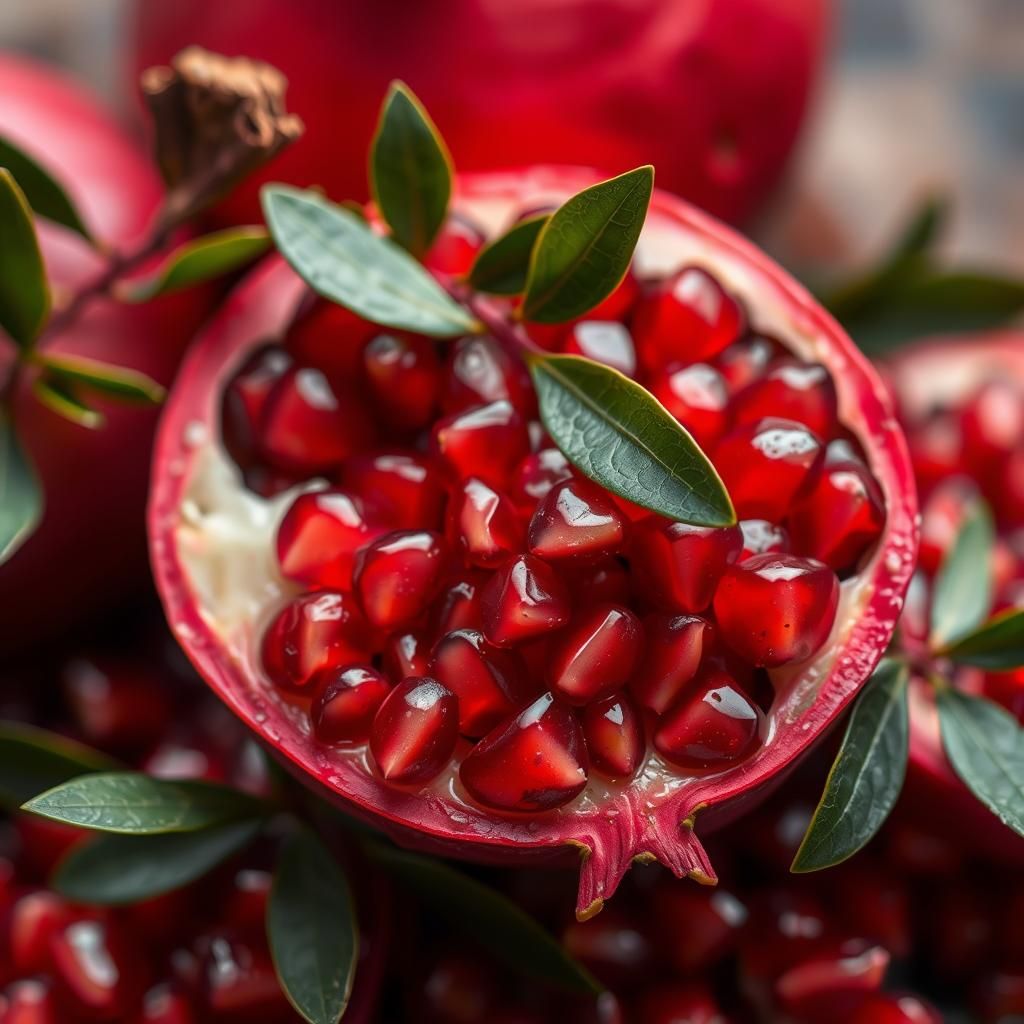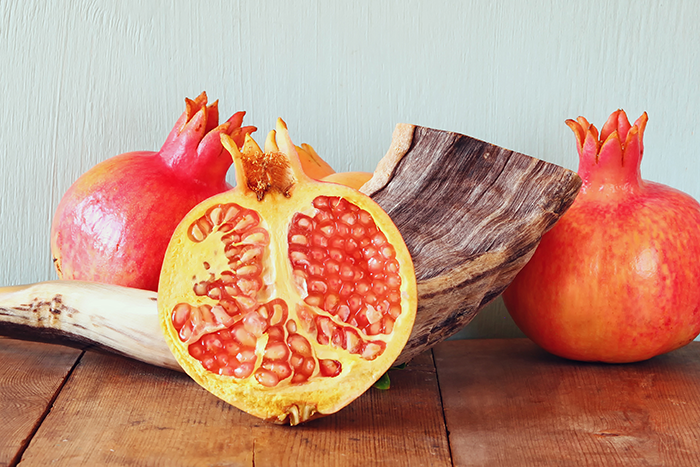Discover How Many Seeds in a Pomegranate: A Complete Guide

Pomegranates are intriguing fruits, not only for their vibrant appearance but also for their unique structure and flavor. One of the most fascinating aspects of this fruit is the number of seeds it contains, which can vary significantly between individual pomegranates. In this complete guide, we will explore the average seed count in a pomegranate, factors that influence this number, and how to effectively extract the seeds for consumption. Whether you're a fan of this delicious fruit or curious about its botanical properties, understanding the seed count can enhance your appreciation of pomegranates. Join us as we delve into the seeds of this remarkable fruit.
How Many Seeds Are in a Pomegranate?
The average pomegranate contains between 200 to 1,400 seeds, with some varieties yielding even more. The number of seeds can depend on the size and health of the fruit, as well as growing conditions. Each seed is encased in a juicy aril, contributing to the fruit's unique flavor and texture. Notably, the seed count can vary from one pomegranate to another, making it a fascinating inquiry for fruit enthusiasts and nutritionists alike.
Variability in Seed Count
The variability in seed count among pomegranates is influenced by factors such as the variety of the fruit, the climate in which it’s grown, and the specific cultivation methods used. Certain types, like the Wonderful pomegranate, are known for having numerous seeds, while others may produce fewer. This natural variability can intrigue consumers and researchers who study genetic diversity in agricultural products.
Health Benefits of Pomegranate Seeds
Pomegranate seeds are packed with essential nutrients and antioxidants. They are especially rich in vitamin C, vitamin K, and fiber, making them a healthy addition to the diet. Eating the seeds, along with their juicy arils, can help support heart health, reduce inflammation, and provide potential anti-cancer properties. Their health benefits, combined with their delicious taste, make them a popular choice for many health-conscious individuals.
How to Extract Seeds from a Pomegranate
Extracting seeds from a pomegranate can be a bit challenging due to the fruit's structure. A common method is to cut the fruit in half and gently tap the back with a wooden spoon, allowing the seeds to fall out. Alternatively, one can score the fruit and separate the segments under water, which helps prevent the arils from bouncing around and makes it easier to collect. This method reduces mess and preserves the integrity of the seeds.
Culinary Uses of Pomegranate Seeds
In culinary contexts, pomegranate seeds are often used for their flavor and vibrant color. They can be sprinkled over salads, used in dressings, or incorporated into desserts. Additionally, the seeds can be juiced to create refreshing beverages or used as a garnish for various dishes, enhancing both the taste and visual appeal. Their versatility makes them a sought-after ingredient in numerous culinary traditions worldwide.
Nutritional Comparison with Other Fruits
When comparing the nutritional content of pomegranate seeds with other seeds and fruits, they stand out for their unique presence of polyphenols and antioxidants. A serving of pomegranate seeds can provide more antioxidants than many other fruits, including blueberries and cranberries. This makes them a valuable addition to a healthy diet and a fascinating subject for those interested in the nutritional benefits of different food types.
| Fruit | Average Seed Count | Antioxidant Level |
|---|---|---|
| Pomegranate | 200-1,400 | High |
| Apple | 5-10 | Moderate |
| Blueberry | 0-10 | High |
| Cranberry | 0-15 | High |
| Watermelon | 200-800 | Moderate |
Are there 613 seeds in a pomegranate?

The notion that there are 613 seeds in a pomegranate is a traditional belief rather than a scientifically verified fact. The exact number of seeds in a pomegranate can vary significantly based on the size, variety, and ripeness of the fruit. While some pomegranates may indeed contain around 613 seeds, others can have more or fewer. Research has shown that the average number of seeds in a pomegranate can range from 200 to even 1,400 seeds.
Pomegranate Seed Count Variability
The number of seeds in a pomegranate can vary greatly. Here are some factors affecting the seed count:
- Fruit Variety: Different varieties produce different numbers of seeds.
- Fruit Size: Larger pomegranates tend to have more seeds.
- Growing Conditions: Factors like soil quality and climate can influence seed development.
Historical Context of the 613 Seeds
The number 613 has significance in many religious and cultural contexts, particularly in Judaism. It is traditionally believed to correspond to the total number of commandments in the Torah. Hence, this connection has made it a popular figure associated with pomegranates.
- Religious Symbolism: Represents abundance and the commandments.
- Cultural Importance: Symbolize prosperity in various cultures.
- Art and Literature: Frequently mentioned in ancient texts and art forms.
Scientific Studies on Pomegranate Seeds
Research has been conducted to ascertain the typical seed count in pomegranates. Although 613 is a nice number, the actual count often deviates.
- Research Findings: Studies suggest variability in seed counts across different pomegranate types.
- Measuring Techniques: Researchers often use statistical methods to estimate average counts.
- Genetic Factors: The seed count can also be influenced by genetic variations among plants.
Nutritional Value of Pomegranate Seeds
Regardless of the number of seeds, pomegranate seeds are packed with nutrients that contribute to health.
See also:
- Rich in Antioxidants: Known for high levels of antioxidants like punicalagins.
- Vitamins and Minerals: Provide essential vitamins such as vitamin C and K.
- Anti-inflammatory Properties: Contribute to better cardiovascular health and reduce inflammation.
Pomegranate Cultivation and Seed Production
The cultivation process of pomegranates influences the overall seed production, with numerous factors at play.
- Soil Quality: Nutrient-rich soil can lead to better fruit and seed development.
- Watering Practices: Adequate irrigation affects the size and number of seeds.
- Pest Management: Healthy trees free of pests can yield more abundant fruit.
How many seeds on average are in a pomegranate?

On average, a pomegranate contains between 200 to 1,400 seeds, depending on the size and variety of the fruit. The typical number of seeds is approximately 600 seeds per fruit. These seeds are enclosed within juicy, edible arils that are rich in antioxidants and nutrients, making pomegranates a popular choice for health-conscious individuals. The exact number of seeds can vary based on several factors, including the plant's genetics and growing conditions.
Factors Affecting Seed Count
The number of seeds in a pomegranate can be influenced by several factors:
- Variety: Different varieties of pomegranates may naturally produce different numbers of seeds.
- Growing Conditions: Environmental factors such as soil quality, water availability, and climate can affect seed development.
- Fruit Size: Generally, larger pomegranates tend to have more seeds than smaller ones.
Nutritional Value of Pomegranate Seeds
Pomegranate seeds are not only known for their taste but also for their impressive nutritional profile:
- Vitamins: They are high in Vitamin C and Vitamin K.
- Antioxidants: Packed with polyphenols, they help combat oxidative stress.
- Fiber: The seeds contribute to dietary fiber intake, promoting digestive health.
Culinary Uses of Pomegranate Seeds
Pomegranate seeds are versatile and can be used in various dishes:
- Salads: They add a burst of flavor and color to salads.
- Garnishes: Used as garnishes for desserts and main courses.
- Juices: Extracted to make delicious and healthy juices.
Health Benefits of Pomegranates
Consuming pomegranates and their seeds is linked to numerous health benefits:
- Heart Health: May improve cholesterol levels and lower blood pressure.
- Anti-Inflammatory Properties: Helps in reducing inflammation in the body.
- Cancer Prevention: Some studies suggest that pomegranates may help reduce the risk of certain cancers.
Harvesting and Processing Pomegranate Seeds
The process of harvesting and extracting seeds from pomegranates requires care and skill:
- Harvesting: Pomegranates are typically harvested between late summer and fall, depending on the region.
- Seed Extraction: This can be done manually or by using tools to split the fruit and release the seeds.
- Storage: Fresh seeds can be stored in the refrigerator for up to a week, while dried seeds can last much longer.
Do all pomegranates have 365 seeds?
No, not all pomegranates have 365 seeds. This is a common myth, largely due to the association of the number 365 with the days of the year. In reality, the number of seeds in a pomegranate can vary widely based on several factors, including the variety of the fruit, its size, and growing conditions. On average, a pomegranate can contain anywhere from 200 to 1,400 seeds, with an approximate average of around 600 seeds.
The Origin of the 365 Seeds Myth
The belief that pomegranates have 365 seeds is largely symbolic and rooted in various cultural traditions.
- Symbolism: The number is often linked to the days of the calendar year, representing fertility and abundance.
- Folklore: In many cultures, pomegranates are considered symbols of life and fertility, leading to the idea that having 365 seeds would signify a complete cycle.
- Misinterpretation: The idea may stem from historical texts or anecdotal references that do not hold scientific validity.
Factors Influencing Seed Count
Various factors can influence the number of seeds in a pomegranate, leading to considerable variations among individual fruits.
- Variety: Different cultivars of pomegranates naturally produce different seed counts.
- Size: Larger fruits tend to have more seeds, while smaller ones may contain fewer.
- Growing conditions: Factors such as soil quality, climate, and irrigation techniques can affect fruit development and seed yield.
Average Seed Count in Pomegranates
While there is no fixed number of seeds per fruit, there are averages that researchers and agricultural experts have documented.
See also:
- Typical Range: Most pomegranates contain between 200 and 1,400 seeds.
- Common Average: On average, a pomegranate has about 600 seeds.
- Research Studies: Studies have shown that the seed count can also vary by location and farming methods employed.
Health Benefits of Pomegranate Seeds
Pomegranate seeds are not just valued for their quantity; they also have numerous health benefits that make them a nutritious addition to any diet.
- Antioxidants: Pomegranate seeds are rich in antioxidants, which help combat oxidative stress.
- Vitamins: They contain essential vitamins such as Vitamin C and several B vitamins.
- Anti-inflammatory Properties: Consuming pomegranate seeds can help reduce inflammation in the body.
Culinary Uses of Pomegranate Seeds
Pomegranate seeds are versatile and can be used in various culinary applications, enhancing both flavor and nutrition.
- Salads: They can be sprinkled on salads for a burst of flavor and color.
- Sauces: Pomegranate seeds can be included in sauces and dressings for added depth.
- Snacking: They are often enjoyed as a fresh snack or added to yogurt and desserts.
Which fruit contains exactly 840 seeds?

The fruit that contains exactly 840 seeds is the pomegranate. The pomegranate (Punica granatum) is a nutrient-rich fruit known for its multiple health benefits, vivid color, and unique flavor. Each pomegranate typically contains between 200 to 1,400 seeds, with the average approaching around 840 seeds. The seeds are encased in a sweet, juicy aril that is rich in antioxidants, vitamins, and minerals.
Health Benefits of Pomegranate
Pomegranates are renowned not only for their delicious taste but also for their numerous health benefits:
- Rich in Antioxidants: Pomegranates contain high levels of antioxidants, which help protect the body from oxidative stress.
- Anti-Inflammatory Properties: The compounds in pomegranates can help reduce inflammation in the body.
- Heart Health: Consuming pomegranate juice has been linked to lower blood pressure and improved heart health.
Culinary Uses of Pomegranate
Pomegranates can be enjoyed in various culinary applications, enhancing dishes with their unique flavor and texture:
- Salads: Pomegranate seeds add a burst of color and sweetness to salads.
- Sauces and Dressings: Pomegranates can be used to create flavorful sauces and vinaigrettes.
- Juices: Pomegranate juice is a popular beverage, often enjoyed for its health benefits.
Cultivation of Pomegranate
Pomegranates thrive in specific climates and require proper cultivation techniques for optimal growth:
- Climate: Pomegranates prefer warm, dry climates, typically found in Mediterranean regions.
- Soil Requirements: They thrive in well-drained, sandy loam soils for the best yield.
- Watering: Pomegranates need moderate watering, especially during fruit development.
Varieties of Pomegranate
There are several different varieties of pomegranates, each with unique characteristics:
- Wonderful: Known for its sweet flavor and large size, the Wonderful variety is the most commercially grown.
- Angel Red: This variety is appreciated for its dark red skin and high juice content.
- Early Wonderful: A variation that ripens earlier in the season, offering similar flavor benefits.
Historical Significance of Pomegranate
The pomegranate has been celebrated throughout history and holds cultural significance in various civilizations:
- Symbol of Fertility: In many cultures, pomegranates symbolize fertility and abundance.
- Religious Significance: Pomegranates appear in various religious texts and ceremonies, symbolizing life and prosperity.
- Ancient Use: Pomegranates have been cultivated since ancient times, with origins tracing back to the region encompassing modern-day Iran and surrounding areas.
Questions from Our Readers
How many seeds are typically found in a pomegranate?
The number of seeds in a pomegranate can vary significantly, but a typical pomegranate contains between 200 to 1,200 seeds. The actual count depends on the variety of the fruit and its ripeness.
Are all pomegranates the same in terms of seed count?
No, not all pomegranates have the same seed count. Different cultivars can produce a varying number of seeds, with some being more seed-heavy while others may have fewer. Generally, larger pomegranates tend to have more seeds than smaller ones.
Why is it important to know the number of seeds in a pomegranate?
Understanding the seed count in a pomegranate can help consumers appreciate the fruit's value and nutritional benefits. More seeds often indicate a juicier and more flavorful fruit, which can enhance culinary experiences and health benefits.
Can the seed count affect the taste of the pomegranate?
Yes, the seed count can influence the taste and texture of the pomegranate. Generally, fruits with more seeds are associated with higher juice content and sweetness, while those with fewer seeds may be less flavorful.
See also:

If you want to read more articles like Discover How Many Seeds in a Pomegranate: A Complete Guide, we recommend you check out our Seeds category.
Leave a Reply

Related Articles